Dive Tour
Night Dives
Dive Tour
Night Dives
This is one all divers talk about! No matter how experienced you are, what your certification level is, our night dives are sure to excite. Hawaii is one of the most isolated chain of islands in the world. While during the day, this paves way to many endemic fish found only in Hawaii, at night it showcases an ecosystem unlike any other. Crowd favorites hard to spot during the daylight come out to hunt and play like octopus, squid, crustaceans like crab, shrimp and lobster, along with moray eels of all shapes, sizes and colors.
Not enough to occupy your drive? Try shutting off your light and dancing with the bioluminescence. Arguably the most fun you can have in the dark!
| What To Bring | Swimwear, Towels, Reef Safe Sunscreen |
|---|---|
| What's Included | Instructor, Equipment, Snacks & Drinks |
| Additional Notes | Please allow adequate travel time. Check GPS and maps. |
From the Pros
All Certified Divers Welcome!
Dive sites are chosen each day based on weather and water conditions, requests for specific sites will be noted.
Click the flags to view the location.
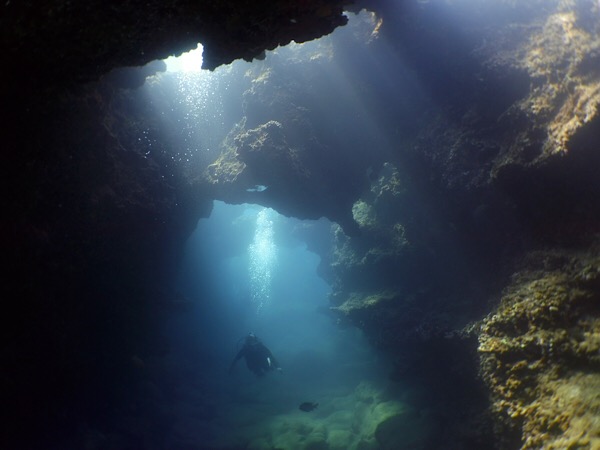
Cathedrals
25 to 60 ft (8-18m)
This is a religious dive experience! Located just behind the fire department, you’ll find this dive temple. Skylights over a large lava tube create a Hawaiian light show not to be missed. Like Sharks Cove this dive in also in the marine sanctuary, so there is lots of marine life to see as well.

Ewa Reef
50 to 80Ft (15-25 m)
This reef dive on the Oahu’s south shore boasts beautiful lava formations and incredible overhangs. The max depth is about 80 feet. The dive depth varies and bottom time is usually about 25 minutes. There is an abundance of fish and a 6-foot turtle sometimes makes an appearance, lots of eels, often rays show up and the occasional white tip reef shark. Visibility here is often 100 feet of more.
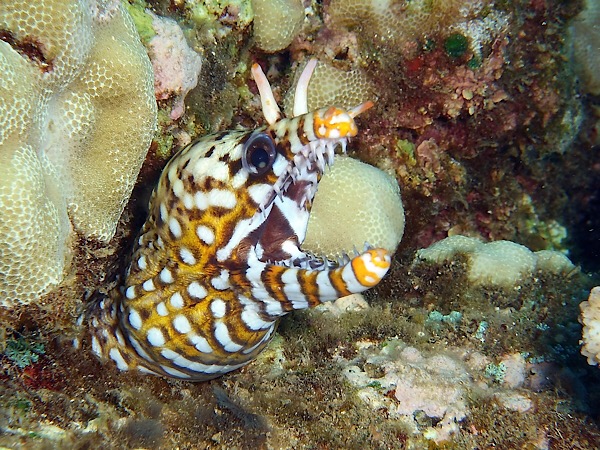
Horseshoe Reef
40 to 65 ft (12-20m)
Another south side double whammy! Horseshoe reef gets its name from its shape. Here you can find several species of eels, pincushion starfish, and antler coral. Swim 50ft (15m) to Kewalo pipe. Keep your eyes peeled for spotted eagle rays off in the distance, and follow along this drainage pipe covered in coral and little critters galore.

Kewalo Pipe
15-60ft (5-20m)
This dive site gets its name from an old storm drain pipe that runs straight out to sea from shore. Adjacent to Horseshoe Reef, it is a great example of South Oahu reef structure. Bright hard corals grow along the pipe itself, as well as the reef surrounding it. Keep an eye out for frogfish! They like to use the corals on the pipe to camouflage themselves. If your air lasts, the reef at the end of the pipe is pristine! Look for large white mouth morey eels and octopus!
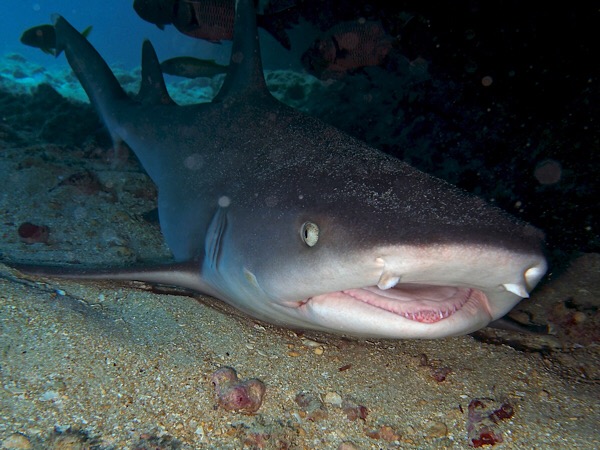
Nautilus
30 to 40ft (9-12m)
Nautilus Reef is a combination of two shallow reefs set upon old lava rock beds. It was named after the glass bottom boat Nautilus that toured the area, but has since been relocated to Guam.
Lots of reef fish here including triggerfish, boxfish, goatfish, tangs. Also sightings of manta rays, stingrays, tiger sharks and grey reef sharks are possible at the outer edges of the reef. Monk seals have been seen here too.
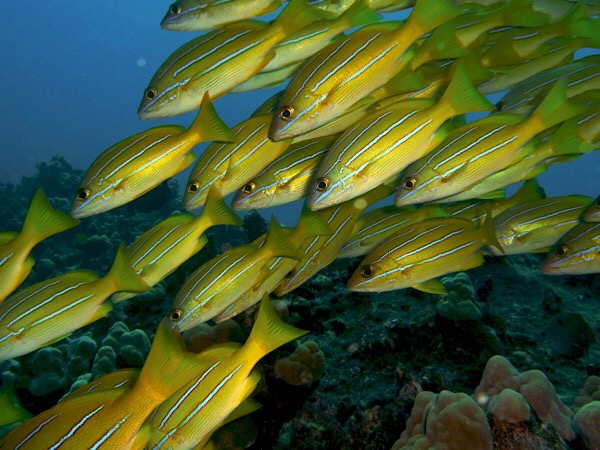
Rainbow Reef
23 - 65Ft (7-20m)
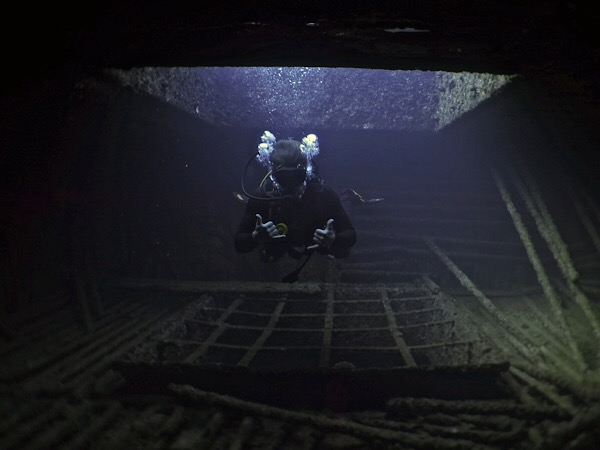
SeaTiger
80 to 130ft (25-40m)
This is an advanced dive as it claims the title for deepest recreational wreck on the island. Originally a fishing vessel, this ship was sank in 1996 by a submarine company for its tours. However, shortly after the company closed and the site quickly became a must dive for locals and visitors. Large schools of pyramid butterflyfish, massive sea turtles, and white tip sharks frequent this wreck.
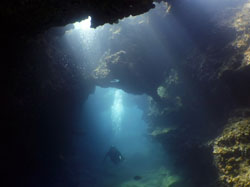
Sharks Cove Arches
20 to 50ft (6-15m)
Located in Pupukea Marine Life Sancturary, This site is perhaps the best example not only Oahu diving, but Hawaii in general. The uniqueness of this site has attracted attention of divers across the globe. Everything from lava tubes and caverns, green sea turtles, endemic fish, dolphin, and monk seals are found to take advantage of this protected marine reserve.

Sharks Cove Tunnels
20 to 50ft (6-15m)
Located in Pupukea Marine Life Sancturary, This site is perhaps the best example not only Oahu diving, but Hawaii in general. The uniqueness of this site has attracted attention of divers across the globe. Everything from lava tubes and caverns, green sea turtles, endemic fish, dolphin, and monk seals are found to take advantage of this protected marine reserve.
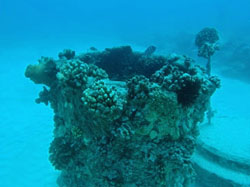
Super Mario World
35 to 45ft (10-14m)
Mario World is named because of the extensive pipe system that covers the area. This is a great spot to find Cowry shells and schools of huge puffer fish. Because of the depth it is great dive site for all of our divers, from students to certified divers just looking for a nice slow-paced reef dive.
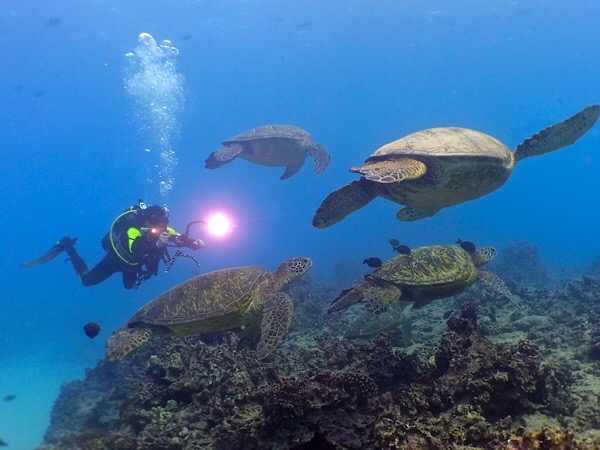
Turtle Canyons
15 to 30ft (5-10m)
Its in the name! As many as a dozen green sea turtles can been seen together here. Take a knee and watch one of the busiest turtle cleaning stations on the island. Several at a time gather to have their shells cleaned by tangs, wrasses and other fish. The turtles are used to divers, so getting a photo with one is usually easy. Don’t touch though, these guys are protected by law.

Turtle Town
30 to 40ft (9-12m)
Turtle Town offers a reef formed on lava that flowed from Haleakala centuries ago. The caverns and ledges in the lava are a perfect habitat for sponges, corals, octopus, fish, eels, and shrimp. The highlight of this reef is the number of Green Sea Turtles. The Green Sea Turtles are an endangered species and must not be touched or harassed. They are very curious animals and often allow snorkelers a good look from just a few feet away.
Tour Details
This is one all divers talk about! No matter how experienced you are, what your certification level is, our night dives are sure to excite. Hawaii is one of the most isolated chain of islands in the world. While during the day, this paves way to many endemic fish found only in Hawaii, at night it showcases an ecosystem unlike any other. Crowd favorites hard to spot during the daylight come out to hunt and play like octopus, squid, crustaceans like crab, shrimp and lobster, along with moray eels of all shapes, sizes and colors.
Not enough to occupy your drive? Try shutting off your light and dancing with the bioluminescence. Arguably the most fun you can have in the dark!
| What To Bring | Swimwear, Towels, Reef Safe Sunscreen |
|---|---|
| What's Included | Instructor, Equipment, Snacks & Drinks |
| Additional Notes | Please allow adequate travel time. Check GPS and maps. |
From the Pros
All Certified Divers Welcome!
Dive sites are chosen each day based on weather and water conditions, requests for specific sites will be noted.
Dive Locations
Click the flags to view the location.

Cathedrals
25 to 60 ft (8-18m)
This is a religious dive experience! Located just behind the fire department, you’ll find this dive temple. Skylights over a large lava tube create a Hawaiian light show not to be missed. Like Sharks Cove this dive in also in the marine sanctuary, so there is lots of marine life to see as well.

Ewa Reef
50 to 80Ft (15-25 m)
This reef dive on the Oahu’s south shore boasts beautiful lava formations and incredible overhangs. The max depth is about 80 feet. The dive depth varies and bottom time is usually about 25 minutes. There is an abundance of fish and a 6-foot turtle sometimes makes an appearance, lots of eels, often rays show up and the occasional white tip reef shark. Visibility here is often 100 feet of more.

Horseshoe Reef
40 to 65 ft (12-20m)
Another south side double whammy! Horseshoe reef gets its name from its shape. Here you can find several species of eels, pincushion starfish, and antler coral. Swim 50ft (15m) to Kewalo pipe. Keep your eyes peeled for spotted eagle rays off in the distance, and follow along this drainage pipe covered in coral and little critters galore.

Kewalo Pipe
15-60ft (5-20m)
This dive site gets its name from an old storm drain pipe that runs straight out to sea from shore. Adjacent to Horseshoe Reef, it is a great example of South Oahu reef structure. Bright hard corals grow along the pipe itself, as well as the reef surrounding it. Keep an eye out for frogfish! They like to use the corals on the pipe to camouflage themselves. If your air lasts, the reef at the end of the pipe is pristine! Look for large white mouth morey eels and octopus!

Nautilus
30 to 40ft (9-12m)
Nautilus Reef is a combination of two shallow reefs set upon old lava rock beds. It was named after the glass bottom boat Nautilus that toured the area, but has since been relocated to Guam.
Lots of reef fish here including triggerfish, boxfish, goatfish, tangs. Also sightings of manta rays, stingrays, tiger sharks and grey reef sharks are possible at the outer edges of the reef. Monk seals have been seen here too.

Rainbow Reef
23 - 65Ft (7-20m)

SeaTiger
80 to 130ft (25-40m)
This is an advanced dive as it claims the title for deepest recreational wreck on the island. Originally a fishing vessel, this ship was sank in 1996 by a submarine company for its tours. However, shortly after the company closed and the site quickly became a must dive for locals and visitors. Large schools of pyramid butterflyfish, massive sea turtles, and white tip sharks frequent this wreck.

Sharks Cove Arches
20 to 50ft (6-15m)
Located in Pupukea Marine Life Sancturary, This site is perhaps the best example not only Oahu diving, but Hawaii in general. The uniqueness of this site has attracted attention of divers across the globe. Everything from lava tubes and caverns, green sea turtles, endemic fish, dolphin, and monk seals are found to take advantage of this protected marine reserve.

Sharks Cove Tunnels
20 to 50ft (6-15m)
Located in Pupukea Marine Life Sancturary, This site is perhaps the best example not only Oahu diving, but Hawaii in general. The uniqueness of this site has attracted attention of divers across the globe. Everything from lava tubes and caverns, green sea turtles, endemic fish, dolphin, and monk seals are found to take advantage of this protected marine reserve.

Super Mario World
35 to 45ft (10-14m)
Mario World is named because of the extensive pipe system that covers the area. This is a great spot to find Cowry shells and schools of huge puffer fish. Because of the depth it is great dive site for all of our divers, from students to certified divers just looking for a nice slow-paced reef dive.

Turtle Canyons
15 to 30ft (5-10m)
Its in the name! As many as a dozen green sea turtles can been seen together here. Take a knee and watch one of the busiest turtle cleaning stations on the island. Several at a time gather to have their shells cleaned by tangs, wrasses and other fish. The turtles are used to divers, so getting a photo with one is usually easy. Don’t touch though, these guys are protected by law.

Turtle Town
30 to 40ft (9-12m)
Turtle Town offers a reef formed on lava that flowed from Haleakala centuries ago. The caverns and ledges in the lava are a perfect habitat for sponges, corals, octopus, fish, eels, and shrimp. The highlight of this reef is the number of Green Sea Turtles. The Green Sea Turtles are an endangered species and must not be touched or harassed. They are very curious animals and often allow snorkelers a good look from just a few feet away.
Photo Gallery
Booking Calendar
You May Also Like
Shallow Reef Boat Dives
As much as 30 percent of the marine life you'll see on our reefs cannot be found anywhere else on earth!
Lava Tube Dives
Encounter underwater topography such as lava tubes, tunnels, trenches, arches and an abundance of protected marine life.


















